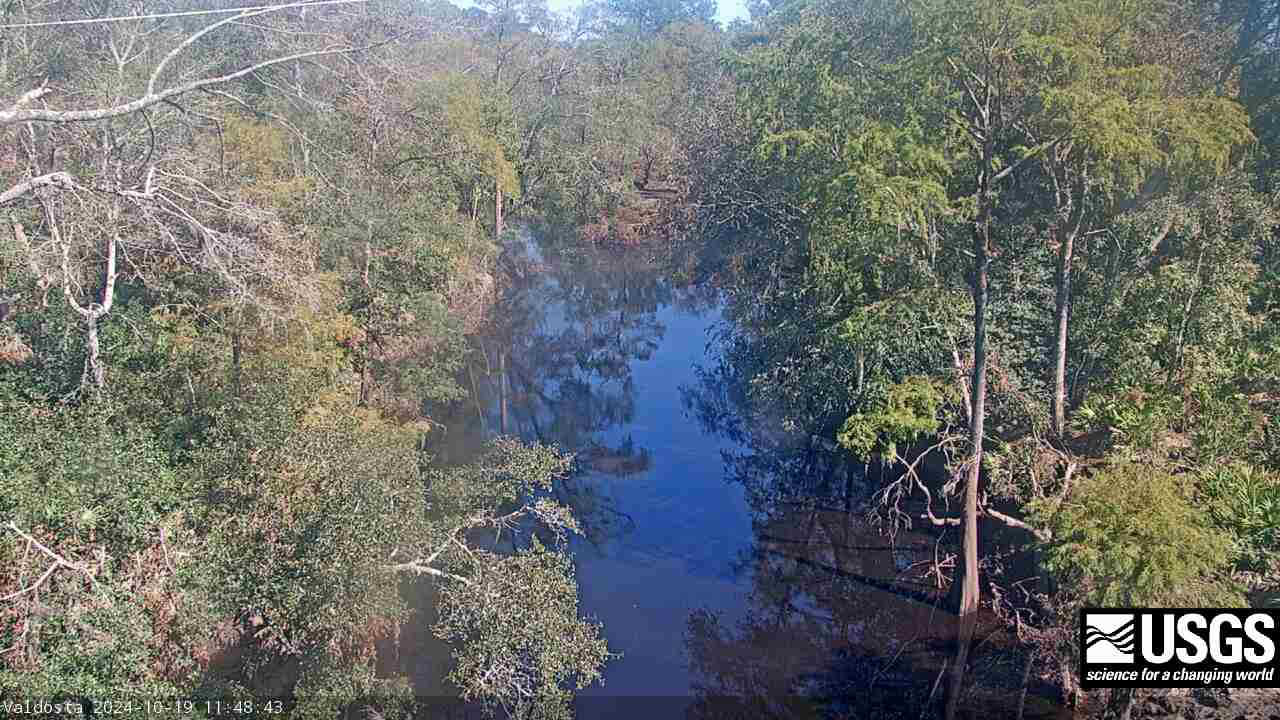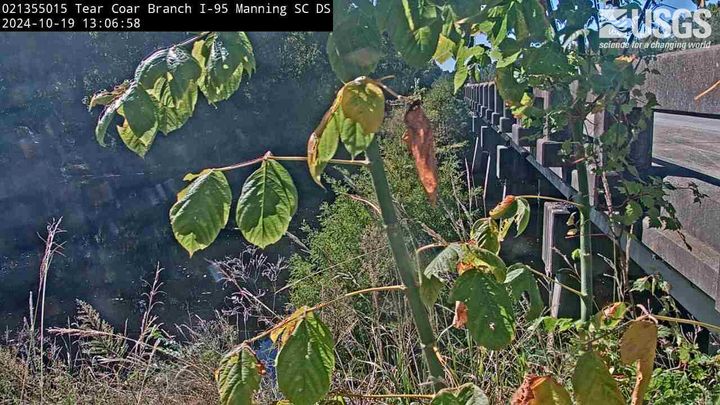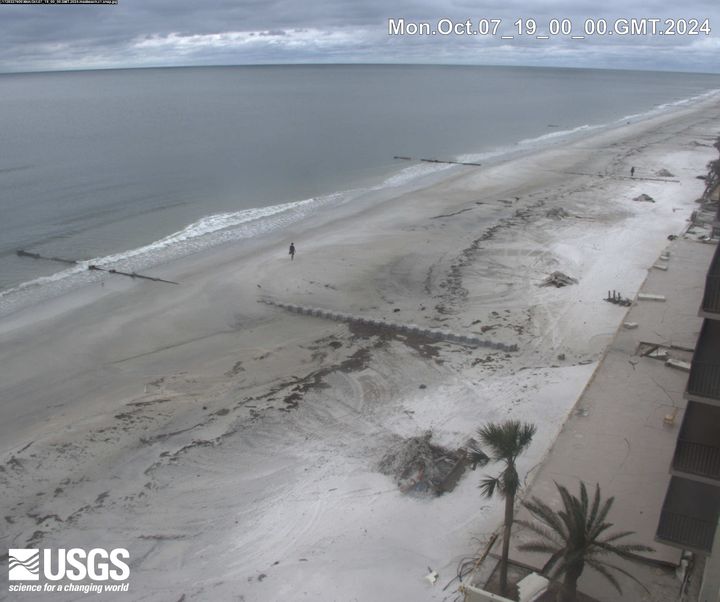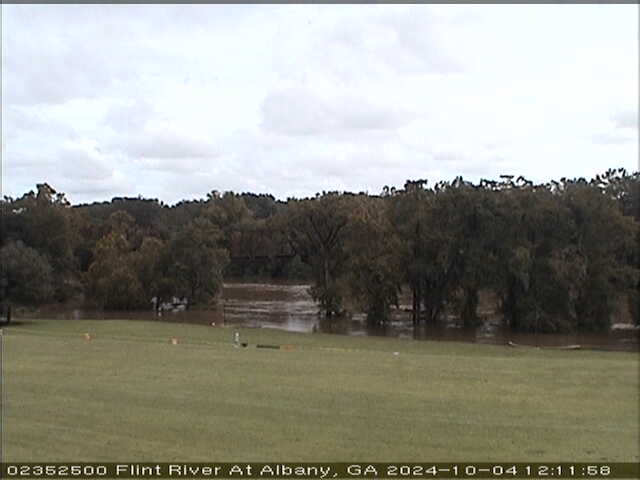Julie Hobbs, a USGS hydrologic technician, installs a wave sensor near Venice, Fla., Monday, October 7, 2024, ahead of Hurricane Milton’s projected landfall in Florida’s Gulf Coast Wednesday. USGS photo by Sean Townsend.
Multimedia
Check out images, video, and audio files from across the Southeast Region.
Images

Julie Hobbs, a USGS hydrologic technician, installs a wave sensor near Venice, Fla., Monday, October 7, 2024, ahead of Hurricane Milton’s projected landfall in Florida’s Gulf Coast Wednesday. USGS photo by Sean Townsend.

USGS Hydrologic Technician Pamela Loftin looks on at the aftermath of severe flooding on Pigeon River in Newport, Tennessee. USGS crews were onsite October 1 to measure high-water marks to determine how high the flood waters reached at this location. Photo by Logan Combs, USGS.
USGS Hydrologic Technician Pamela Loftin looks on at the aftermath of severe flooding on Pigeon River in Newport, Tennessee. USGS crews were onsite October 1 to measure high-water marks to determine how high the flood waters reached at this location. Photo by Logan Combs, USGS.
Andrew Robinson, a USGS hydrological technician, is making a measurement at Ebenezer Creek at Springfield, GA. This site number is 02198690. (Photo by Andrew Robinson, USGS.)
Andrew Robinson, a USGS hydrological technician, is making a measurement at Ebenezer Creek at Springfield, GA. This site number is 02198690. (Photo by Andrew Robinson, USGS.)
Drew Robinson, a USGS hydrological technician, is putting a Rapid Deployment Gauge together for the Georgia Department of Transportation on Wednesday, August 7. He built the RDG and deployed it in Statesboro in the early evening. That RDG was used to help the local community experiencing bad floods on Lotts Creek.
Drew Robinson, a USGS hydrological technician, is putting a Rapid Deployment Gauge together for the Georgia Department of Transportation on Wednesday, August 7. He built the RDG and deployed it in Statesboro in the early evening. That RDG was used to help the local community experiencing bad floods on Lotts Creek.

U.S. Geological Survey, Caribbean Florida Water Science Center main office, located in 10770 N 46th St, Tampa, FL 33617.
U.S. Geological Survey, Caribbean Florida Water Science Center main office, located in 10770 N 46th St, Tampa, FL 33617.
Mail in deceased butterflies, moths, and skippers and help United States Geological Survey(USGS) scientists establish a Lepidoptera Research Collection (LRC). Specimens will help USGS scientists identify contaminants and environmental factors which may be contributing to the decline of insect populations.
Mail in deceased butterflies, moths, and skippers and help United States Geological Survey(USGS) scientists establish a Lepidoptera Research Collection (LRC). Specimens will help USGS scientists identify contaminants and environmental factors which may be contributing to the decline of insect populations.
Videos
Ammonia or ammonium? What’s the difference? In water, ammonia (NH3) and ammonium (NH4+) exist together in an equilibrium that depends on pH and temperature. As the temperature or pH rise, ammonia (NH3) becomes more abundant. This is important because ammonia is more toxic than ammonium.
Ammonia or ammonium? What’s the difference? In water, ammonia (NH3) and ammonium (NH4+) exist together in an equilibrium that depends on pH and temperature. As the temperature or pH rise, ammonia (NH3) becomes more abundant. This is important because ammonia is more toxic than ammonium.
This animated nitrogen fixation video provides an overview of natural and industrial nitrogen fixation, along with benefits, costs, trends, and effects on ecosystems.
This animated nitrogen fixation video provides an overview of natural and industrial nitrogen fixation, along with benefits, costs, trends, and effects on ecosystems.
This animated nitrogen fixation video provides an overview of natural and industrial nitrogen fixation, along with benefits, costs, trends, and effects on ecosystems.
This animated nitrogen fixation video provides an overview of natural and industrial nitrogen fixation, along with benefits, costs, trends, and effects on ecosystems.
This animation of the biogeochemical nitrogen cycle illustrates the main steps of the cycle in air, water, and soils. The video explains and connects the many forms of nitrogen, such as ammonia, ammonium, hydroxylamine, nitrite, nitrate, nitrous oxide, and nitrogen dioxide, and explains the role of nitrate in nitric oxide signaling in the human body.
This animation of the biogeochemical nitrogen cycle illustrates the main steps of the cycle in air, water, and soils. The video explains and connects the many forms of nitrogen, such as ammonia, ammonium, hydroxylamine, nitrite, nitrate, nitrous oxide, and nitrogen dioxide, and explains the role of nitrate in nitric oxide signaling in the human body.
This animation of the biogeochemical nitrogen cycle illustrates the main steps of the cycle in air, water, and soils. The video explains and connects the many forms of nitrogen, such as ammonia, ammonium, hydroxylamine, nitrite, nitrate, nitrous oxide, and nitrogen dioxide, and explains the role of nitrate in nitric oxide signaling in the human body.
This animation of the biogeochemical nitrogen cycle illustrates the main steps of the cycle in air, water, and soils. The video explains and connects the many forms of nitrogen, such as ammonia, ammonium, hydroxylamine, nitrite, nitrate, nitrous oxide, and nitrogen dioxide, and explains the role of nitrate in nitric oxide signaling in the human body.
The island of Puerto Rico is subject to numerous natural hazards including hurricanes and coastal erosion. Information on how the island’s coastal environments respond to these events is critical for bolstering coastal resilience. Dr.
The island of Puerto Rico is subject to numerous natural hazards including hurricanes and coastal erosion. Information on how the island’s coastal environments respond to these events is critical for bolstering coastal resilience. Dr.
Audio
Welcome to the USGS Ecosystems Mission Area Outstanding in the Field podcast series that tells stories about our science, our adventures, and our efforts to better understand fish and wildlife and the ecosystems that support them.
The USGS Ecosystems Mission Area brings you Outstanding in the Field, a series of stories about our science, our adventures, and our efforts to better understand our fish and wildlife and the ecosystems that support them. In this episode we describe the USGS’s efforts to track frog populations in the southeast United States.
The USGS Ecosystems Mission Area brings you Outstanding in the Field, a series of stories about our science, our adventures, and our efforts to better understand our fish and wildlife and the ecosystems that support them. In this episode we describe the USGS’s efforts to track frog populations in the southeast United States.
Can you hear the difference between the non-native Cuban treefrog and two common Louisiana native treefrogs? Cuban treefrogs’ call is distinctive. Biologist Paul Moler of the Florida Fish and Wildlife Conservation Commission recorded them in South Florida. Credit: Paul Moler, used with permission.
Green treefrogs call from their favorite habitat, rivers and lakes. They’re native to Louisiana and Florida, where these were recorded. Credit: Paul Moler, used with permission.
Squirrel treefrogs are also native to Florida and Louisiana. Hear them calling from ditches, puddles and other ephemeral pools of water. Credit: Paul Moler, used with permission.
North Carolina, like many years before, is responding to flooding in the East and drought in the West. Holly Weyers, USGS North Carolina Water Science Center Director, discusses these extreme events.
Webcams
The most recent view of the beach from a coastal camera on Sand Key, Florida. Updates every 60 minutes.
The most recent view of the beach from a coastal camera on Sand Key, Florida. Updates every 60 minutes.
A coastal camera located on Medeira Beach, Florida near the Shoreline Island Resort.
A coastal camera located on Medeira Beach, Florida near the Shoreline Island Resort.
We have installed a webcam at the Flint River at Albany to allow you to view, in real time, the current river-stage conditions.
During periods of flooding, the South Atlantic Water Science Center - Georgia will take control of the camera.
We have installed a webcam at the Flint River at Albany to allow you to view, in real time, the current river-stage conditions.
During periods of flooding, the South Atlantic Water Science Center - Georgia will take control of the camera.

Video camera bright image at Tres Palmas in Rincón, on the west coast of Puerto Rico. [Larger version]
Learn more about the cameras and how we're using them to study wave dynamics.
Video camera bright image at Tres Palmas in Rincón, on the west coast of Puerto Rico. [Larger version]
Learn more about the cameras and how we're using them to study wave dynamics.

We have installed a webcam at the Withlacoochee River at Skipper Bridge Rd. near Bemiss, GA to allow you to view, in real time, the current river-stage conditions.
During periods of flooding, the South Atlantic Water Science Center will take control of the camera.
We have installed a webcam at the Withlacoochee River at Skipper Bridge Rd. near Bemiss, GA to allow you to view, in real time, the current river-stage conditions.
During periods of flooding, the South Atlantic Water Science Center will take control of the camera.

We have installed a webcam at Tearcoat Branch at I-95, near Manning to allow you to view (in real time) the current river-stage conditions.
During periods of flooding, the South Atlantic Water Science Center will take control of the camera.
Camera is sponsored by the SC Department of Transportation.
We have installed a webcam at Tearcoat Branch at I-95, near Manning to allow you to view (in real time) the current river-stage conditions.
During periods of flooding, the South Atlantic Water Science Center will take control of the camera.
Camera is sponsored by the SC Department of Transportation.
















